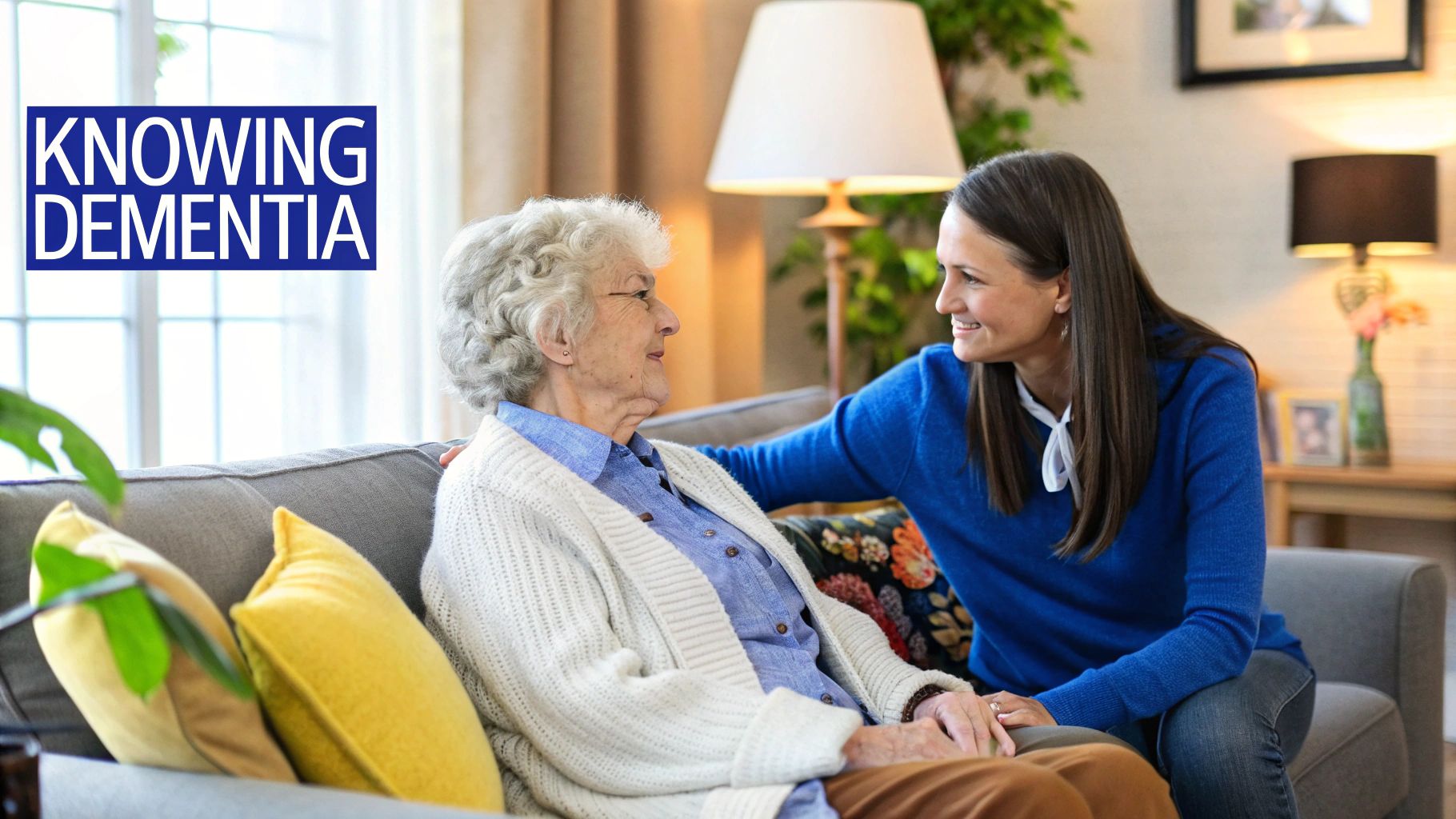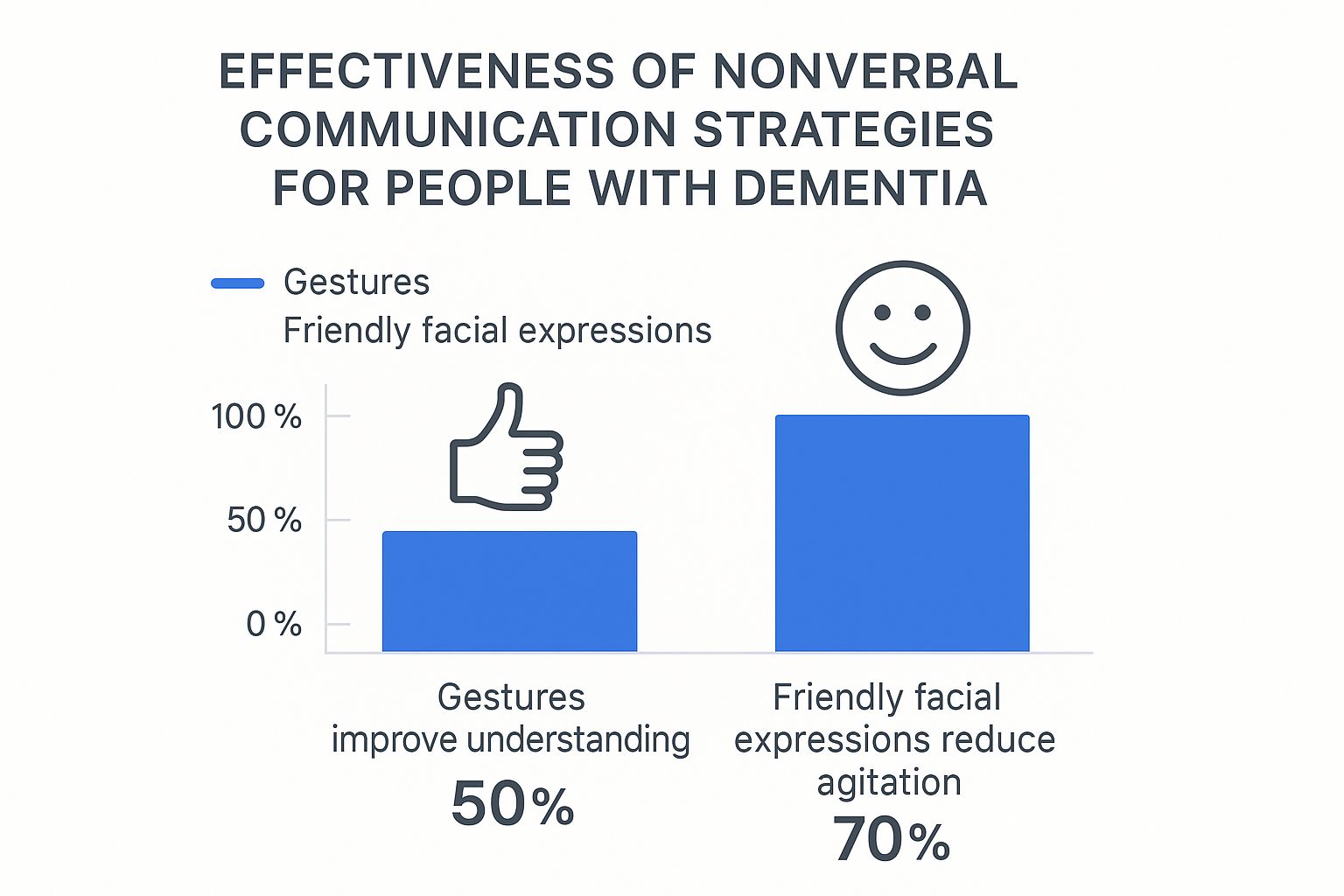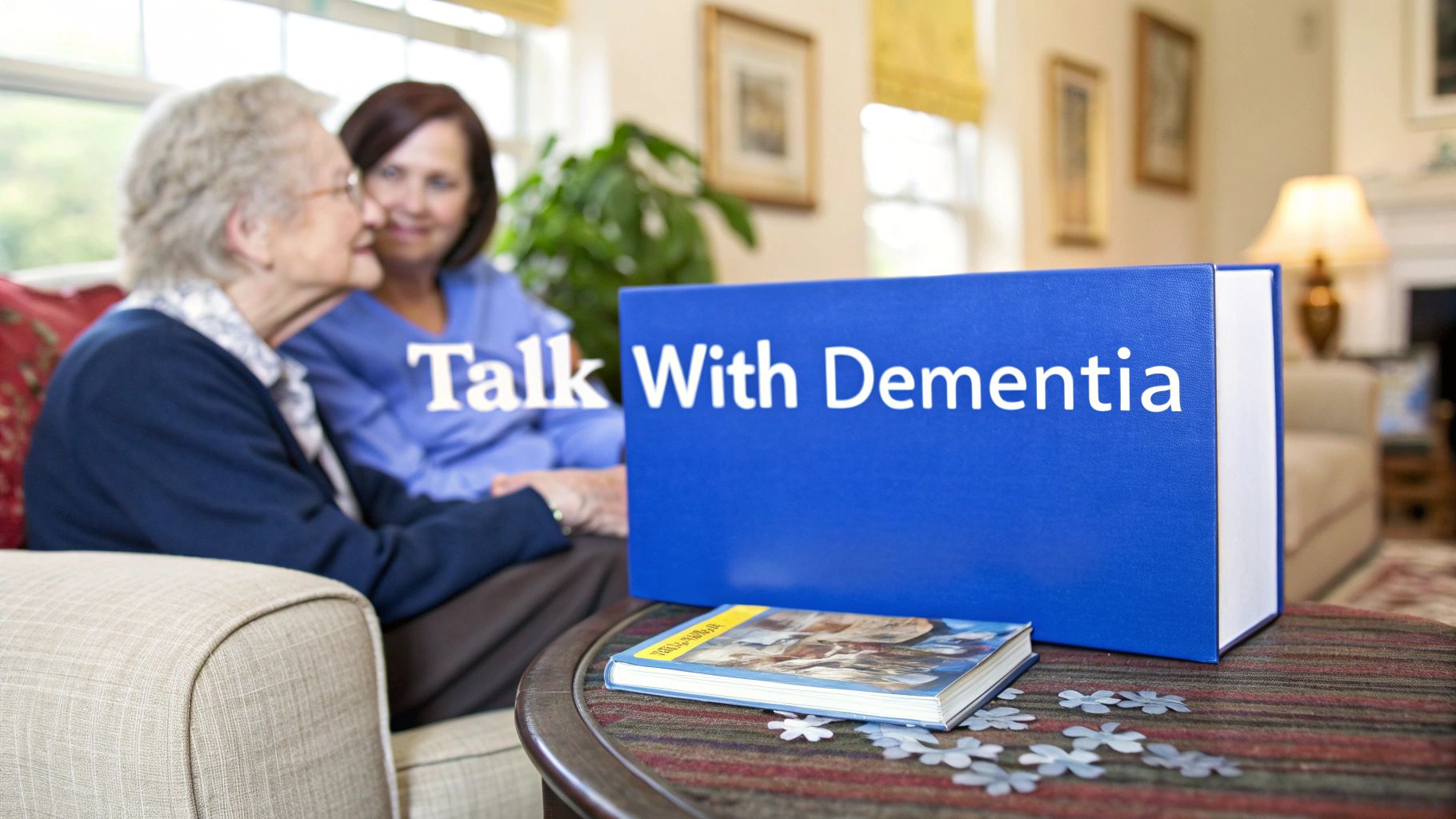Why Traditional Conversation Fails With Dementia

Standard conversations can become frustrating for both individuals with dementia and their caregivers. This difficulty arises because dementia gradually affects cognitive functions, impacting language processing and memory. These changes affect how a person with dementia understands and responds to information. Even simple questions, like "What did you have for breakfast?", can become a significant challenge, leading to feelings of confusion, anxiety, and isolation.
The Impact of Cognitive Decline on Communication
Dementia's impact on language varies with the stage of the disease. Early on, individuals may struggle to find the right words or follow complex conversations. As dementia progresses, these challenges increase. They may misinterpret words, struggle to form sentences, or lose the ability to comprehend spoken language. These changes make everyday conversations, which we often take for granted, incredibly difficult.
Short-term memory loss also contributes to communication breakdowns. A person with dementia might forget what was just said, ask the same question repeatedly, or lose track of the conversation's topic. While this can be frustrating for caregivers, understanding that these repetitions are due to memory impairment, not intentional disregard, fosters patience and empathy.
Furthermore, dementia affects emotional regulation. Individuals with dementia might experience exaggerated emotional responses or unpredictable mood swings. A harmless comment could trigger anger or frustration. This emotional volatility adds another layer of complexity to effective communication.
The prevalence of dementia is a growing global concern, affecting over 55 million people worldwide as of 2020. This number is projected to nearly double every 20 years, reaching 139 million by 2050. Effective communication is essential for improving the quality of life and supporting the independence of individuals with dementia. More detailed statistics can be found here: https://www.alzint.org/about/dementia-facts-figures/dementia-statistics/
Why Specialized Communication Techniques Are Essential
Because typical conversation is often ineffective, specialized communication techniques are crucial for interacting with individuals with dementia. These techniques acknowledge the cognitive and emotional changes caused by dementia. They offer strategies for simplifying language, minimizing distractions, and using non-verbal cues. Learning and implementing these strategies allows caregivers and loved ones to maintain meaningful connections and improve overall well-being. These approaches will be discussed in the following sections.
Setting the Stage for Successful Conversations

When learning how to talk to someone with dementia, the environment plays a crucial role. Creating a positive physical and emotional atmosphere can significantly improve communication. This involves considering everything from minimizing background noise to choosing the optimal time of day for conversations. These seemingly minor details can have a major impact.
Optimizing the Physical Environment
Think of the physical environment as the foundation of your conversation. A calm and comfortable space minimizes distractions and encourages focus. For example, turn off the television or radio during conversations to reduce sensory overload. Adequate lighting is essential, as shadows can be disorienting. Also, ensure the room temperature is comfortable. These adjustments create a more relaxing and supportive setting for communication.
Timing and Seating Arrangements
Choosing the right time for a conversation is just as important as the physical environment. Individuals with dementia may experience periods of increased alertness. Schedule conversations during these times to optimize understanding. Also, consider seating arrangements. Sitting face-to-face, at eye level, promotes engagement and allows you to observe non-verbal cues. Avoid standing over the person, which can feel intimidating. These simple changes can make a noticeable difference.
Creating Emotional Safety
Beyond the physical environment, creating emotional safety is essential for meaningful conversations. Approach the individual with empathy, patience, and respect. Use a gentle and reassuring tone of voice. Validate their feelings and avoid arguing or correcting them, even if their statements seem inaccurate. It's important to create a safe space where they feel comfortable expressing themselves. This fosters trust and encourages open communication.
The World Health Organization (WHO) reports that more than 60% of people with dementia live in low- and middle-income countries, highlighting the importance of adaptable communication strategies. Adapting these strategies to different cultural contexts is key for effective communication. This could involve incorporating culturally familiar objects or activities into conversations. Creating a supportive environment, both physically and emotionally, ultimately enhances interaction quality and strengthens connections with individuals experiencing dementia.
Words That Connect Instead of Confuse

The infographic above illustrates the importance of nonverbal communication when interacting with individuals with dementia. It highlights the comparative effectiveness of gestures and friendly facial expressions. While gestures are helpful, friendly facial expressions demonstrate a greater positive impact, reducing agitation and promoting connection. This emphasizes the significant role nonverbal cues play in dementia care.
Now, let's explore the specific words and phrases that can either facilitate communication or create confusion when talking to someone with dementia. Understanding how dementia affects language processing is key to adapting our communication style effectively.
Simplifying Language and Sentence Structure
People with dementia often find complex sentences and abstract language challenging. Short, simple sentences with concrete language are much easier to process. For example, instead of saying, "We're going to your doctor's appointment this afternoon," try a simpler phrase like, "We're going to see Dr. Smith later today." Also, avoid using pronouns like "he," "she," or "it" without clearly stating who or what they refer to. This helps avoid confusion and promotes understanding.
Mastering the Art of Effective Questioning
Asking the right questions is crucial for encouraging responses and engaging someone with dementia. Closed-ended questions, requiring a simple "yes" or "no" answer, are generally easier to manage than open-ended questions. Instead of asking, "What did you do today?", which involves considerable memory recall, try a question like, "Did you enjoy your lunch today?" This focused approach can make communication more comfortable and successful.
The Power of Pauses and Processing Time
Allowing ample time for responses is also essential. Dementia can impact processing speed, so avoid interrupting or rushing the conversation. After asking a question, pause and give the individual sufficient time to formulate their answer. Patience is key to effective communication. The prevalence of dementia increases with age, affecting approximately 6% to 10% of people over 65. This percentage rises significantly with advancing age, making communication challenges more prevalent. For further statistics, see: https://pmc.ncbi.nlm.nih.gov/articles/PMC6195406/
Using Positive and Reassuring Language
The words we use can significantly influence the emotional well-being of a person with dementia. Focusing on positive and reassuring language is vital. Instead of saying, "Don't worry," which can sometimes feel dismissive, try saying, "I'm here with you." This subtle change in wording fosters a more supportive and comforting environment. For more communication tips, read: How to master communication. By implementing these verbal strategies, we can improve understanding, reduce frustration, and maintain meaningful connections with individuals experiencing dementia.
To further illustrate effective communication techniques, consider the following table:
Effective vs. Ineffective Verbal Communication
This table compares helpful and unhelpful approaches to verbal communication with dementia patients.
| Communication Challenge | Ineffective Approach | Effective Approach | Why It Works |
|---|---|---|---|
| Complex Instructions | "Take your medication, then put on your coat and go to the living room to wait for your daughter." | "Let's take your medication. Now, put on your coat. Great! Now, let's go to the living room to wait for your daughter." | Breaking down instructions into smaller, manageable steps makes them easier to follow. |
| Asking about the Day | "What did you do today?" | "Did you enjoy your activity today?" | Closed-ended questions require less memory recall and are easier to answer. |
| Expressing Reassurance | "Don't worry." | "I'm here with you. Everything is alright." | Positive and reassuring language offers comfort and support without dismissing concerns. |
| Giving Directions | "It's down the hall on the left." | "Let's walk down the hall together. Your room is the first door on the left." | Offering clear and specific guidance, combined with physical presence, reduces confusion and anxiety. |
This table summarizes some key communication challenges and provides practical examples of how to improve interactions. By understanding these strategies, we can create a more positive and supportive environment for individuals with dementia.
When Body Language Speaks Louder Than Words
As verbal communication becomes more challenging for someone with dementia, non-verbal communication takes center stage. Understanding the science behind this shift can empower caregivers to connect more effectively. Physical presence and expressions can often reach individuals with dementia when words fail, fostering a sense of comfort and understanding.
The Power of Non-Verbal Cues
When determining how to connect with someone who has dementia, consider the importance of understanding and using their existing soft skills. Non-verbal communication taps into emotional centers of the brain that remain relatively preserved, even in advanced stages of dementia. A gentle touch, a warm smile, or direct eye contact can convey reassurance and understanding more powerfully than spoken words.
These cues bypass the language processing centers, which are often impaired, establishing a deeper connection. Imagine trying to communicate with someone who speaks a different language. You would naturally rely on gestures and facial expressions to get your meaning across. This analogy applies perfectly to communicating with someone with dementia.
Using Touch, Facial Expressions, and Body Positioning
Specific techniques can enhance non-verbal communication. A light touch on the hand or arm can convey warmth and empathy. Maintaining eye contact demonstrates presence and engagement. Mirroring the individual's body language can create a sense of connection and shared understanding.
However, it's crucial to be mindful of cultural norms and personal preferences regarding touch. Some individuals may not be comfortable with physical contact. Always approach touch with sensitivity and respect.
Interpreting Non-Verbal Cues from the Person with Dementia
Learning to interpret non-verbal cues from someone with dementia is equally important. Facial expressions, body language, and vocalizations can provide valuable insights into their emotions and needs. Are they agitated, relaxed, or in pain? Are they trying to communicate something specific?
Observing these subtle signals can help you understand what they are experiencing and respond appropriately. A furrowed brow might signal discomfort, while a relaxed posture suggests contentment. Learning to decipher these cues is like learning a new language, one that unlocks deeper understanding.
Case Studies and Examples
Numerous case studies from memory care settings highlight the effectiveness of non-verbal communication. In one instance, a caregiver successfully calmed an agitated resident by gently holding their hand, making eye contact, and speaking in a soft, reassuring tone.
In another case, a family member connected with their loved one by looking at old photographs together and reminiscing through non-verbal cues like smiles and nods. These examples demonstrate the power of non-verbal communication to bridge communication gaps and create meaningful connections, even with cognitive decline. These strategies are vital tools for interacting with and caring for those with dementia.

Handling Challenging Moments With Confidence
Caring for someone with dementia presents unique challenges. Repetitive questions, confabulations (fabricated stories), accusations, and emotional outbursts are common occurrences. These behaviors can be incredibly difficult for caregivers, leaving them feeling overwhelmed and uncertain. This section offers practical strategies used by experienced dementia care professionals to navigate these difficult moments.
Validation Without Reinforcement
When a loved one with dementia expresses a false belief, our first instinct is often to correct them. However, this approach can frequently lead to increased frustration and agitation. A more effective approach is to validate their feelings without reinforcing the inaccurate belief.
For example, if someone insists their deceased mother is coming for dinner, instead of saying, "Your mother is gone," try, "I understand you miss your mother. It sounds like it would be nice to have dinner with her again." This response acknowledges their emotion and validates their feelings without agreeing with the inaccuracy.
Redirection Without Dismissal
Redirection is another important tool, but it's crucial to use it gently and respectfully, without dismissing the person's concerns. If they repeatedly ask to go home, avoid saying, "You are home." This can be disorienting and upsetting.
Instead, try, "It sounds like you want to feel safe and comfortable. Let's look at some family photos that might make you feel more at home." This gently redirects their focus while still acknowledging their underlying need for comfort and security.
De-escalation During Heightened Emotions
Emotional outbursts are a common part of dementia. When these occur, the most important thing is to remain calm and avoid arguing. Try to identify the trigger for the outburst. Is it a specific person, place, or activity?
Once you've identified a potential trigger, try to remove it or gently redirect their attention. Sometimes, simply changing the environment or offering a comforting activity can help de-escalate the situation. Learn more in our article about how to master communication in challenging situations.
Recognizing Unmet Needs
Sometimes, challenging behaviors are a way for individuals with dementia to express unmet physical or emotional needs. A person constantly asking for a deceased spouse might be experiencing loneliness. Someone repeatedly asking to go home might be feeling disoriented or unsafe.
It’s important to learn to look beyond the words and try to interpret the underlying need. For example, if they repeatedly ask for a specific item, instead of focusing on the impossibility of finding it, try offering alternatives that might fulfill the same need. If they ask for their old work shoes, perhaps they simply want comfortable footwear.
To better understand how communication strategies should adapt to the different stages of dementia, the following table provides valuable guidance:
Communication Strategies by Dementia Stage
This table outlines how communication approaches should evolve as dementia progresses through different stages.
| Dementia Stage | Common Communication Challenges | Recommended Approaches | Things to Avoid |
|---|---|---|---|
| Early Stage | Difficulty finding words, forgetting names, mild confusion | Use simple language, provide cues and reminders, be patient | Correcting minor errors, rushing conversations |
| Middle Stage | Increased confusion, difficulty following complex instructions, repetitive questions | Use visual aids, break down tasks into smaller steps, offer choices | Arguing, asking open-ended questions |
| Late Stage | Limited verbal communication, difficulty understanding speech, nonverbal communication becomes prominent | Focus on nonverbal cues, use touch and gestures, maintain a calm and reassuring presence | Raising your voice, talking down to them |
This table highlights the importance of adapting communication methods as dementia progresses. Recognizing the common challenges of each stage helps caregivers tailor their approach effectively, promoting understanding and reducing frustration.
Real-World Scripts and Approaches
Here are some practical examples of how to rephrase common responses to challenging behaviors:
- Repetitive Questions: Instead of saying, "I've told you several times already…," try, "I know you’re interested in this. Let’s talk about something else for now, and we can come back to it later."
- Confabulations: Instead of saying, "That’s not true at all!," try, "That sounds like quite an adventure. Tell me more about it."
- Accusations: Instead of saying, "How can you say that to me?!," try, "I hear that you're upset. I'm here for you. Tell me what's bothering you."
These simple shifts in language can significantly improve communication. By validating feelings, redirecting gently, and recognizing unmet needs, you can build stronger connections and improve the well-being of individuals with dementia. These practical tips will help you maintain composure during challenging conversations and ensure that interactions remain respectful and dignified, even in the face of difficult behaviors.
Finding Joy and Connection Beyond Words
Communicating with someone living with dementia isn't always about straightforward conversations. It's more about nurturing the emotional connection, especially when traditional conversations become difficult. This involves finding ways to connect on a deeper, more emotional level, emphasizing shared experiences and sensory engagement. This change in approach can be incredibly valuable, facilitating meaningful interactions even as dementia progresses.
The Power of Shared Activities
Think of communication as a two-way street. When words become less reliable, shared activities offer a powerful way to connect. Simple things like listening to music, looking at old photos, or gentle physical touch can create significant moments of shared experience. These activities access preserved memories and emotions, creating a sense of familiarity and comfort. For example, a beloved song from the past can evoke joy and trigger memories, even if the person can't express them verbally.
Focusing on Remaining Abilities
Dementia can bring a sense of loss for both the individual and their family. However, concentrating on what abilities remain, instead of what's been lost, can open doors to new connections. Perhaps the person still enjoys gardening, painting, or singing. These activities become valuable tools for engagement, allowing self-expression and a sense of accomplishment. You might be interested in: How to master communication with someone with dementia.
Expressing Affection in New Ways
As verbal communication becomes more challenging, discovering new ways to show affection is crucial. A gentle touch, a warm smile, or simply holding their hand communicates love and reassurance. These non-verbal expressions bypass the language processing areas of the brain, speaking directly to the emotional core. This means that even when words are gone, the message of love can still be received.
Finding Unexpected Moments of Clarity
Even in advanced stages of dementia, unexpected moments of clarity can emerge. These moments, sometimes called "lucid intervals," are incredibly valuable. They offer a glimpse of the person's former self and provide opportunities for meaningful connection. Be ready to cherish these moments when they arise. They may be brief, but they bring great joy and strengthen the enduring bond. For support in navigating the emotional journey of caregiving, explore resources on how to be emotionally strong.
Navigating Grief and Finding Hope
Acknowledging the grief that accompanies a loved one's cognitive decline is important. This grief is normal and understandable. Yet, amidst the difficulties, there is still hope for connection and joy. By focusing on remaining abilities, expressing affection in new ways, and creating shared experiences, meaningful relationships can be maintained, and moments of joy discovered, even while facing dementia. These approaches enrich the lives of individuals with dementia and offer comfort and support for their caregivers.
Are you looking for compassionate, personalized care for a loved one with dementia in the Princeton, NJ area? Caring Hands Senior Services provides a variety of services to support seniors and individuals with disabilities, allowing them to age in place comfortably and with dignity. Learn more about our services and how we can help. We serve Mercer County, including Hamilton, Princeton, and nearby areas, offering personal care, nursing services, respite care, and companionship.



